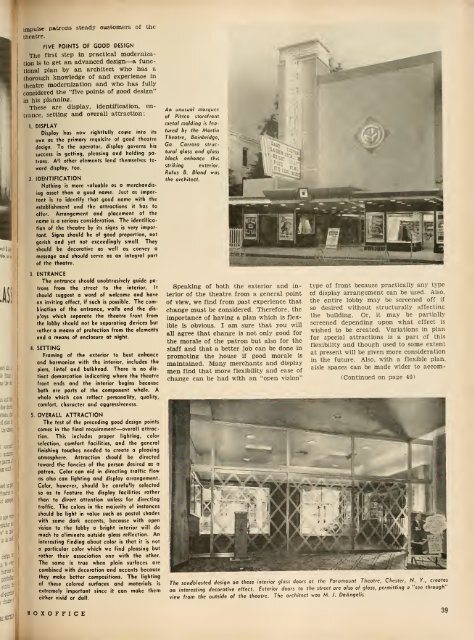Create successful ePaper yourself
Turn your PDF publications into a flip-book with our unique Google optimized e-Paper software.
impulse pfctrons steady oustomers of the<br />
theatre.<br />
FIVE POINTS OF GOOD DESIGN<br />
The first step in practical modernization<br />
is to get an advanced design— a functional<br />
plan by an architect who has a<br />
thorough knowledge of and experience In<br />
theatre modernization and who has fully<br />
considered the "five points of good design"<br />
in his planning.<br />
These are display, identification, entrance,<br />
setting and overall attraction:<br />
1. DISPLAY<br />
Display has now rightfully cofie into its<br />
own as the primary requisite of good theatre<br />
design. To the operator, display governs his<br />
success in getting, pleasing and holding patrons.<br />
A'l other elements lend themselves toward<br />
display, too.<br />
2. IDENTIFICATION<br />
Nothing is more valuable as a merchandising<br />
asset than a good name. Just as important<br />
is to identify that good name with the<br />
establishment and the attractions it has to<br />
offer. Arrangement and placement of the<br />
name is a serious consideration. The identification<br />
of the theatre by its signs is very important.<br />
Signs should be of good proportion, not<br />
garish ond yet not exceedingly small. They<br />
should be decorative as well as convey a<br />
message and should serve as an integral part<br />
of the theatre.<br />
3. ENTRANCE<br />
The entrance should unobtrusively guide patrons<br />
from the street to the interior. It<br />
should suggest a word of welcome and have<br />
on inviting effect, if such is possible. The combination<br />
of the entrance, walls and the disp'ays<br />
which separate the theatre front from<br />
the lobby should not be separating devices but<br />
rather a means of protection from the elements<br />
and a means of enclosure at night.<br />
4. SETTING<br />
Framing of the exterior to best enhance<br />
and harmonize with the interior, includes the<br />
piers, lintel and bulkhead. There is no distinct<br />
demarcation indicating where tha theatre<br />
front ends and the interior begins because<br />
both are parts of the component whole. A<br />
whole which can reflect personality, quality,<br />
comfort,<br />
character and aggressiveness.<br />
5. OVERALL ATTRACTION<br />
The test of the preceding good design points<br />
comes in the final requirement—overall attraction.<br />
This includes proper lighting, color<br />
selection, comfort facilities, and the general<br />
finishing touches needed to create a pleasing<br />
atmosphere. Attraction should be directed<br />
toward the fancies of the person desired as a<br />
patron. Color can aid in directing traffic flow<br />
OS also can lighting and display arrangement.<br />
Color, however, should be carefu'ly selected<br />
so OS to feature the display facilities rather<br />
than to divert attention unless for directing<br />
traffic. The colors in the majority of instances<br />
should be light in value such as pastel shades<br />
with some dark accents, because with open<br />
vision to the lobby a bright interior will do<br />
much to eliminate outside glass reflection. An<br />
interesting finding about color is that it is not<br />
particular color which we find pleasing but<br />
rather their association one with the other.<br />
The same is true when plain surfaces are<br />
combined with decoration and accents because<br />
they make better compositions. The lighting<br />
of these colored surfaces and materials is<br />
extremely important since it can make them<br />
either vivid or dull.<br />
An unusual<br />
marquee<br />
of Pittco storefront<br />
metal molding is featured<br />
by the Martin<br />
Theatre,<br />
Bainbridge,<br />
Ga. Carrara structural<br />
glass and glass<br />
block enhance this<br />
striking<br />
exterior<br />
Rufus B. Bland was<br />
the architect.<br />
Speaking of both the exterior and interior<br />
of the theatre from a general point<br />
of view, we find from past experience that<br />
change must be considered. Therefore, the<br />
importance of having a plan which is flexible<br />
Is obvious. I am sure that you will<br />
all agree that change is not only good for<br />
the morale of the patron but also for the<br />
staff and that a better job can be done in<br />
promoting the house if good morale is<br />
maintained. Many merchants and display<br />
men find that more flexibility and ease of<br />
change can be had with an "open vision"<br />
type of front because practically any type<br />
of display arrangement can be used. Also,<br />
the entire lobby may be screened off if<br />
so desired without .structurally affecting<br />
the building. Or, it may be partially<br />
screened depending upon what effect is<br />
wished to be created. Variations in plan<br />
for special attractions is a part of this<br />
flexibUity and though used to some extent<br />
at present will be given more consideration<br />
in the future. Also, with a flexible plan,<br />
aisle spaces can be made wider to accom-<br />
(Continued on page 40)<br />
The sandblasted design on these interior glass doors at the Paramount Theatre. Chester, N. Y.. creates<br />
on interesting decoratiye effect, ixterior doors to the street are also of glass, permitting a "see through"<br />
view from the outside of the theatre. The architect was M. J. DeAngelis<br />
BOXOFFICE 39

















